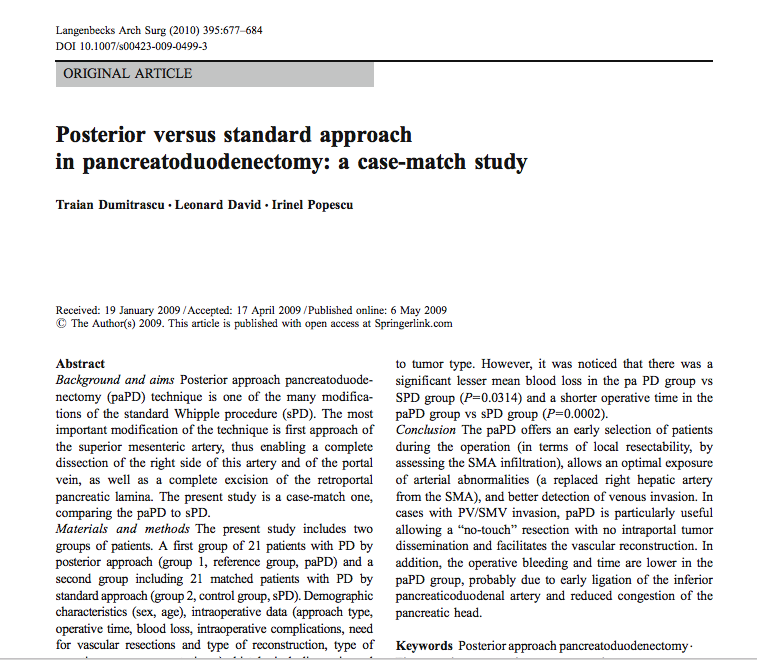Autori:
Traian Dumitrascu & Leonard David & Irinel Popescu
Fundeni Clinical Institute, Bucharest, Romania
Rezumat:
Background and aims Posterior approach pancreatoduodenectomy (paPD) technique is one of the many modifications of the standard Whipple procedure (sPD). The most important modification of the technique is first approach of the superior mesenteric artery, thus enabling a complete dissection of the right side of this artery and of the portal vein, as well as a complete excision of the retroportal pancreatic lamina. The present study is a case-match one, comparing the paPD to sPD.
Materials and methods The present study includes two groups of patients. A first group of 21 patients with PD by posterior approach (group 1, reference group, paPD) and a second group including 21 matched patients with PD by standard approach (group 2, control group, sPD). Demographic characteristics (sex, age), intraoperative data (approach type, operative time, blood loss, intraoperative complications, need for vascular resections and type of reconstruction, type of resection upon remnant tissue), histological diagnosis and pathology data (tumor location, TNM staging, tumor grading, tumor vascular invasion), patient outcomes (postoperative length of stay, in-hospital postoperative mortality and morbidity, survival time) were analyzed in both groups of patients and compared.
Results There were no significant differences in the two groups regarding early morbidity and mortality rates, length of hospitalization, overall survival, and survival according to tumor type. However, it was noticed that there was a significant lesser mean blood loss in the pa PD group vs SPD group (P=0.0314) and a shorter operative time in the paPD group vs sPD group (P=0.0002).
Conclusion The paPD offers an early selection of patients during the operation (in terms of local resectability, by assessing the SMA infiltration), allows an optimal exposure of arterial abnormalities (a replaced right hepatic artery from the SMA), and better detection of venous invasion. In cases with PV/SMV invasion, paPD is particularly useful allowing a “no-touch” resection with no intraportal tumor dissemination and facilitates the vascular reconstruction. In addition, the operative bleeding and time are lower in the paPD group, probably due to early ligation of the inferior pancreaticoduodenal artery and reduced congestion of the pancreatic head.
Materials and methods The present study includes two groups of patients. A first group of 21 patients with PD by posterior approach (group 1, reference group, paPD) and a second group including 21 matched patients with PD by standard approach (group 2, control group, sPD). Demographic characteristics (sex, age), intraoperative data (approach type, operative time, blood loss, intraoperative complications, need for vascular resections and type of reconstruction, type of resection upon remnant tissue), histological diagnosis and pathology data (tumor location, TNM staging, tumor grading, tumor vascular invasion), patient outcomes (postoperative length of stay, in-hospital postoperative mortality and morbidity, survival time) were analyzed in both groups of patients and compared.
Results There were no significant differences in the two groups regarding early morbidity and mortality rates, length of hospitalization, overall survival, and survival according to tumor type. However, it was noticed that there was a significant lesser mean blood loss in the pa PD group vs SPD group (P=0.0314) and a shorter operative time in the paPD group vs sPD group (P=0.0002).
Conclusion The paPD offers an early selection of patients during the operation (in terms of local resectability, by assessing the SMA infiltration), allows an optimal exposure of arterial abnormalities (a replaced right hepatic artery from the SMA), and better detection of venous invasion. In cases with PV/SMV invasion, paPD is particularly useful allowing a “no-touch” resection with no intraportal tumor dissemination and facilitates the vascular reconstruction. In addition, the operative bleeding and time are lower in the paPD group, probably due to early ligation of the inferior pancreaticoduodenal artery and reduced congestion of the pancreatic head.
Publicat:
Langenbecks Arch Surg (2010) 395:677–684
[gview file=”https://www.chirurgiehbp.ro/wp-content/uploads/2016/08/ARCHBPTH007.pdf”]

